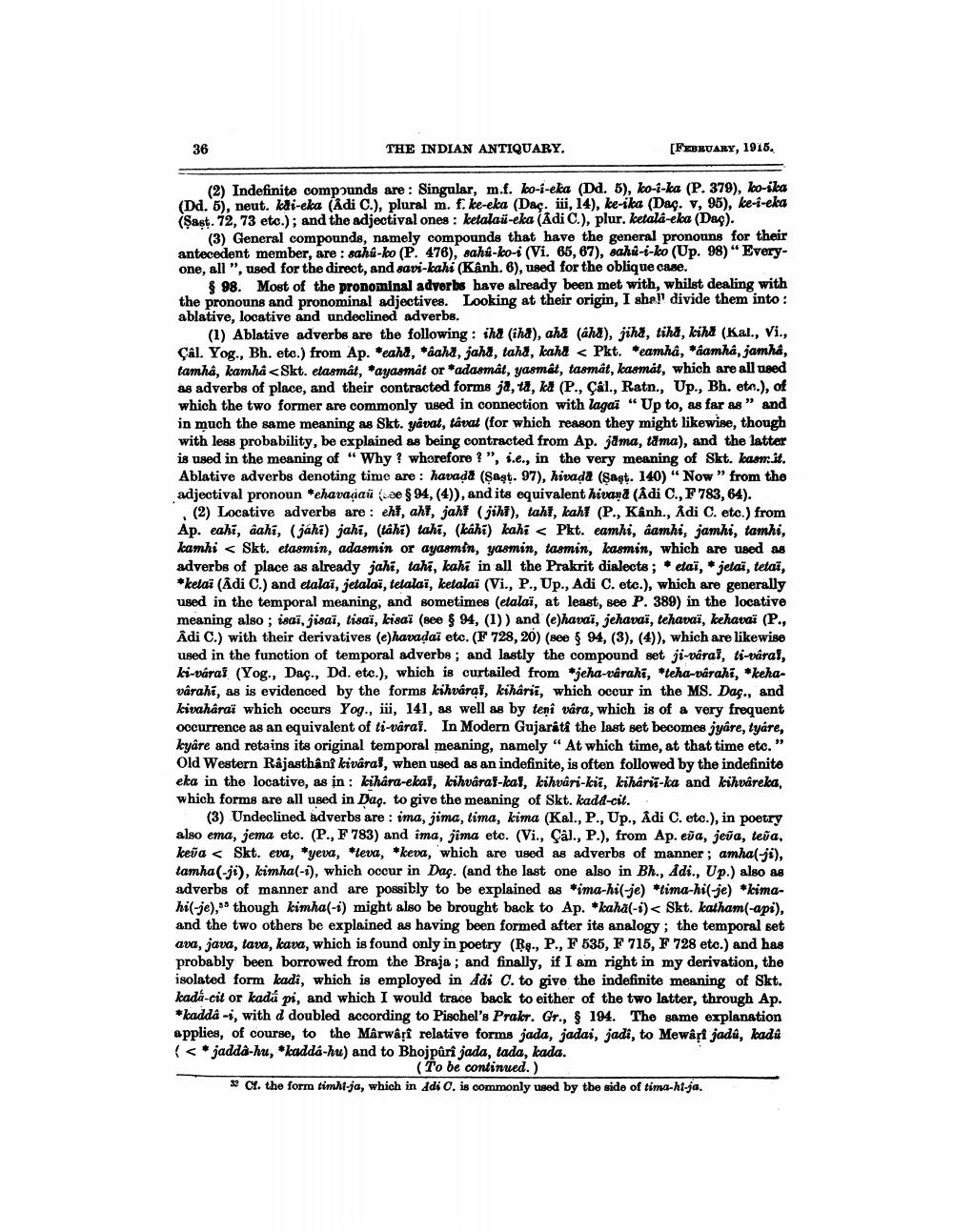________________
36
THE INDIAN ANTIQUARY.
[FEBRUARY, 1915.
(2) Indefinite compounds are: Singular, m.f. ko-1-eka (Dd. 5), ko-i-ka (P. 379), ko-ika (Dd. 5), neut. kdi-eka (Adi C.), plural m. f. ke-eka (Daç. iii, 14), ke-ika (Dac. V, 95), ke-i-eka (Sast. 72, 73 etc.); and the adjectival ones : ketalaü-eka (Adi C.), plur. ketala-eka (Das).
(3) General compounds, namely compounds that have the general pronouns for their antecedent member, are : sahú-ko (P. 476), sahi-ko-i (Vi. 65, 67), sahi-i-ko (Up. 98) "Everyone, all ”, used for the direct, and savi-kahi (Kênh. 6), used for the oblique case.
$98. Most of the pronominal adverbs have already been met with, whilst dealing with the pronouns and pronominal adjectives. Looking at their origin, I she divide them into : ablative, locative and undeclined adverbs.
(1) Ablative adverbs are the following: iha (iha), aha (aha), jiha, tiha, kiha (Kal., Vi., Çal. Yog., Bh. etc.) from Ap. *eaha, Haaha, jaha, taha, kaht < Pkt. *eamhå, *aamha, jamha, tamha, kamhâ <Skt. etasmát, *ayasmát or *adasmat, yasmát, tasmât, kasmát, which are all used as adverbs of place, and their contracted forms ja, to, ka (P., Çal., Ratn., Up., Bh. etc.), of which the two former are commonly used in connection with lagaï " Up to, as far as " and in much the same meaning as Skt. yavat, taval (for which reason they might likewise, though with less probability, be explained as being contracted from Ap. jama, tama), and the latter is used in the meaning of "Why? wherefore ? ", i.e., in the very meaning of Skt. kasm.it. Ablative adverbs denoting time are : havada (şaşt. 97), hivada (Saşt. 140) "Now” from the adjectival pronoun *ehavadaü (еe $ 94, (4)), and its equivalent hivana (Adi C., F783, 64).
(2) Locative adverbs are: ehi, ahi, jahi (jihi), tahi, kahi (P., Kanh., Adi C. etc.) from Ap. eahi, aahi, (jahi) jahi, (tahi) tahi, (kahi) kahi < Pkt. eamhi, aamhi, jamhi, tamhi, kamhi < Skt. etasmin, adasmin or ayasmin, yasmin, tasmin, kasmin, which are used as adverbs of place as already jahi, tahi, kahi in all the Prakrit dialects; *etai, jetai, tetai, *kelai (Adi C.) and etalai, jetalai, telalai, ketalaï (Vi., P., Up., Adi C. etc.), which are generally used in the temporal meaning, and sometimes (etalai, at least, see P. 389) in the locative meaning also; isai, jisai, tisai, kisaī (see $ 94, (1)) and (e)havai, jehavai, tehavai, kehavai (P., Âdi C.) with their derivatives (e)havadai etc. (F 728, 20) (see $ 94, (3), (4)), which are likewise used in the function of temporal adverbs; and lastly the compound set ji-varai, ti-váral, ki-várai (Yog., Dac., Dd. etc.), which is curtailed from *jeha-varahi, teha-värahi, *kehavarahi, as is evidenced by the forms kihvarai, kiharü, which occur in the MS. Doç., and kivaharaï which occurs Yog., ii, 141, as well as by teni vára, which is of a very frequent occurrence as an equivalent of ti-várat. In Modern Gujarati the last set becomes jyáre, tyáre, kyare and retains its original temporal meaning, namely" At which time, at that time etc." Old Western Rajasthani kiváral, when used as an indefinite, is often followed by the indefinite eka in the locative, as in: kihara-ekai, kihvaraf-kal, kihvári-kii, kiharüi-ka and kihvâreka, which forms are all used in Dag. to give the meaning of Skt. kadd-cit.
(3) Undeclined adverbs are : ima, jima, tima, kima (Kal., P., Up., Adi C. etc.), in poetry also ema, jema etc. (P., F 783) and ima, jima etc. (Vi., Çal., P.), from Ap. eva, jeña, teia, keữa < Skt. eva, *yeva, leva, *keva, which are used as adverbs of manner; amha(-ji), tamha(-ji), kimha(-1), which occur in Daf. (and the last one also in Bh., Adi., Up.) also as adverbs of manner and are possibly to be explained as *ima-hil-je) *lima-hil-je) *Limahis-je), though kimha(-i) might also be brought back to Ap. *kaha(-i) < Skt. katham(-api), and the two others be explained as having been formed after its analogy; the temporal set ava, java, tava, kava, which is found only in poetry (Ro., P., F 535, F 715, F 728 etc.) and has probably been borrowed from the Braja; and finally, if I am right in my derivation, the isolated form kadi, which is employed in Adi C. to give the indefinite meaning of Skt. kada-cit or kadá pi, and which I would trace back to either of the two latter, through Ap. *kadda -i, with a doubled according to Pischel's Prakr. Gr., $ 194. The same explanation applies, of course, to the Mârwâți relative forms jada, jadai, jadi, to Mewâri jadů, kada (<* jadda-hu, *kadda-hu) and to Bhojpûri jada, tada, kada.
(To be continued. ) » C4. the form timhi-ja, which in Adi C. is commonly used by the side of tima-hi-ja.




